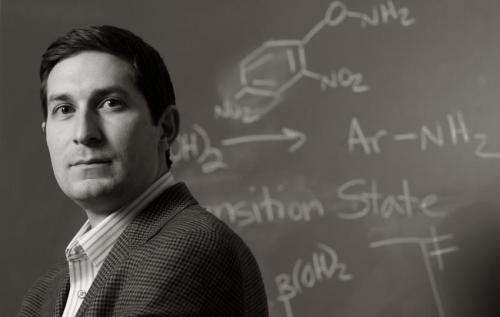Discovery opens door for better way of making medicine

(Phys.org)—To make most medicines, metals like copper are needed for a critical chemical reaction.
Afterward, pharmaceutical makers need to remove the metal to make the material safe for human consumption.
They might be spared the trouble in the future thanks to a discovery by a Brigham Young University chemist and collaborators at The University of Texas Southwestern Medical Center.
The researchers did something that has eluded scientists for several decades: They converted typically unreactive boronic acids to compounds known as aryl amines. The aryl amine functionality is ubiquitous in chemistry and this new methodology provides a novel route to their synthesis – without the use of a metal catalyst.
"This is a conceptual breakthrough and a novel reaction more than anything," said BYU chemistry professor Daniel Ess.
The findings were published recently in the Journal of the American Chemical Society. The industry magazine Chemical and Engineering News also highlighted the work.
Ess and his students at BYU use theories to predict which organic materials could produce desired chemical reactions. Typically, their work guides how the researchers at Southwestern Medical Center set up their experiments.
This time, however, it worked in reverse: Laszlo Kurti of Southwestern Medical found a successful compound and asked Ess to figure out why it worked.
"A whole bunch of other compounds look very similar but failed," Ess said. "This one has the proper reactivity without decomposing. One of the bonds doesn't break until it goes in the reaction."
Pharmaceutical companies won't be the only ones interested in developing this approach. The study authors note the potential agricultural uses with the production of pesticides and fertilizers.
Journal information: Journal of the American Chemical Society
Provided by Brigham Young University



















